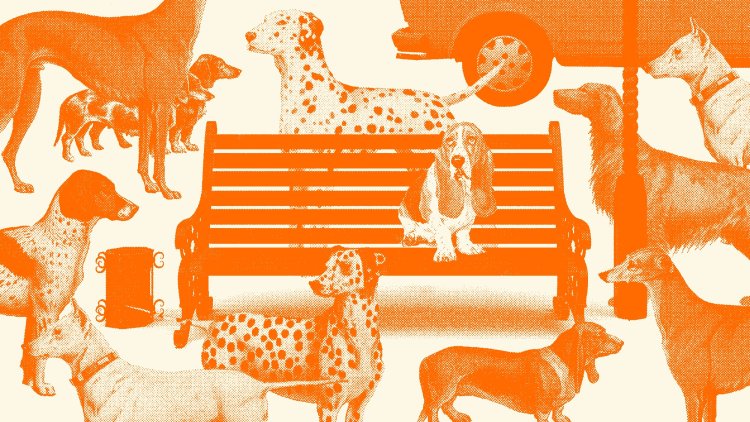New Yorkers Won’t Stop Complaining About Dogs
In such a densely packed city, space can feel zero sum.

This is an edition of Time-Travel Thursdays, a journey through The Atlantic’s archives to contextualize the present and surface delightful treasures. Sign up here.
“Dogs are so numerous in New York, indeed, that they have already become a nuisance,” the journalist Charles Dawson Shanly wrote in The Atlantic in 1872. He was annoyed by “all the barking … and there is a good deal of it.” Other New Yorkers feared that the dogs roaming the streets were “deleterious to health” (a reasonable concern, given the risk of rabies at the time). Eventually, Shanly wrote, anxieties escalated to the point that “weakminded people began to look upon Ponto’s kennel in the back yard as a very Pandora’s box of maladies too numerous and appalling to be contemplated without terror.”
Some 150 years later, the city’s canine population is rabies free, and you’re unlikely to see any feral dogs running around. But New Yorkers haven’t stopped complaining. “I’m sorry, dog lovers. There are too many of you,” Chloë Sevigny told Rolling Stone in January. “Why Does Everyone Hate My Dog?” a writer for New York magazine wondered earlier this year.
Dogs are everywhere in New York. They play, walk, and—controversially—poop in the same streets and parks that everyone else enjoys, just as they have for centuries. Today, they sometimes even eat in the same restaurants (whether they’re allowed to or not). Sharing public places with dogs might seem easy enough, but in a city so densely packed, space can feel zero sum. It’s perhaps inevitable that some wonder: Why do dogs get dominion over so much of it?
Back in Shanly’s era, New Yorkers weren’t too concerned about pet dogs—but they were very worried about strays. Around the middle of the 19th century, officials devised a brutal method to deal with them: Police would round up unattended dogs, bring them to the newly created pound, and, if no one claimed them, drown whole packs at a time. “The lamentations set up by [the dogs] are pitiful to hear,” Shanly wrote after witnessing a drowning.
To some, the violence was a necessary evil; humans and feral dogs truly couldn’t safely coexist. “It is better that such should be their end than that our worthy citizens should live in fear of a bite,” read an 1855 New York Times article. But as the drownings continued, early animal-rights activists protested, and by the end of the century, New York’s pound had been replaced by the beginnings of a shelter system (though for decades, those also killed most of the dogs they took in).
With the stray-dog problem more under control, anti-canine attention shifted to pet dogs—specifically, to their excrement. The streets were filthy. Signs in the late 1930s encouraged owners to curb their dogs. The hope was that any waste on the curb would flow more easily to the gutter instead of dirtying the sidewalks.
But the city still wasn’t clean enough. In the 1970s, a new movement emerged, pushing for laws that would require owners to clean up their dog’s poop, as the writer Kelly Conaboy reported in The Atlantic last year. Some people suspected that the movement’s leader, Fran Lee, hoped to ultimately ban dogs from the city entirely, though she denied the claim. (Lee’s anti-animal ire wasn’t limited to dogs. In 1974, she complained to The Atlantic about pigeon waste: “Pigeons are dirty, dirty, dirty animals,” she told a reporter, “and every single one of them should be taken away.”) The city never banned dogs, but a law requiring owners to pick up after their dogs passed in 1978.
Today, scooping is the norm. A few skirmishes have broken out over violators (whom the Department of Sanitation pledged to crack down on in 2022, though enforcement remains minimal), but modern debates about dogs in the city are largely about more than where they go to the bathroom: Should dogs be able to play in parks alongside kids? What about if they’re unleashed, or if it’s a sports field specifically built for children? Do people really need to bring their pets with them everywhere?
In some communities, dogs can feel like a bellwether of gentrification—both proof of the changes taking place in a neighborhood and another force drying up limited resources. They may not be the physical threat they once were, but in the absence of real danger, views have grown more polarized. The dog-loving faction has perhaps never been more devoted, seeing dogs as members of their family and pushing the limits of where their beloved pets can accompany them. Meanwhile, people on the other side are subject to just as much barking, shedding, and licking as ever, sometimes in places they weren’t before. The next frontier of the dog wars may be finding a way not just to coexist, but to do so happily.
What's Your Reaction?




















